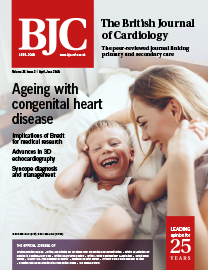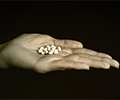2018, Volume 25, Issue 2, pages 41–80

2018, Volume 25, Issue 2, pages 41–80
Editorials Clinical articles News and viewsTopics include:-
- Ageing with congenital heart disease
- Implications of Brexit for medical research
- Advances in 3D echocardiography
- Syncope diagnosis and management
Editorials
Back to top
June 2018 Br J Cardiol 2018;25:46–7 doi:10.5837/bjc.2018.015
Congenital heart disease: an ageing problem
Gabrielle Norrish, Juan Pablo Kaski

Congenital heart disease (CHD) is the most common congenital anomaly, with an estimated prevalence of eight per 1,000 births.1 However, reliable data on long-term survival for this heterogeneous group of patients are still lacking. Previous population-based studies from the US reported age-standardised mortality rates secondary to CHD of 1.2 per 100,000.2 Mortality was highest during infancy (48.1% of all deaths occurred under the age of one year), however, the majority of the remaining deaths occurred outside of childhood, following transition to adult care. Yet, while it is accepted that individuals with CHD may have a higher mortality compared with the general population, the wide spectrum of disease means interpretation of population-based mortality rates for individual lesions is difficult. Additionally, a significant number of studies report only on short-term follow-up, meaning that long-term outcomes are unknown. A previous systematic review reported pooled survival estimates for common CHD lesions, however, it only included studies from hospital-based cohorts with survival estimates calculated from the time of surgical repair.3 It, therefore, does not account for those patients who do not need surgical intervention and may not be representative of all patients with CHD. Knowing the expected mortality rates for CHD is not only important for family counselling, but also in service planning.

April 2018 Br J Cardiol 2018;25:48–9 doi:10.5837/bjc.2018.009
Implications of Brexit for medical research
Chloe Watson

On 23 June 2016, the UK public took to the polls and voted to leave the European Union (EU). Since that vote, everyone – from the farming community to the financial sector – has been trying to digest the result and understand what it might mean for them. The science community has been no exception, and with good reason. Scientific research is widely acknowledged as an international endeavour and, until now, EU membership has played a role in this. Science is also a real UK strength – UK institutions, when compared internationally, are ranked second in the world for the quality of their research,1 and the UK has one of the largest drug development pipelines globally – making it all the more important that we secure a positive future for UK science post-Brexit.
April 2018 Br J Cardiol 2018;25:50 doi:10.5837/bjc.2018.010
Celebrating 25 years of the Scottish Cardiac Society
Hany Eteiba

In September last year, the Scottish Cardiac Society (SCS) celebrated its 25th anniversary with a two-day symposium held in Crieff – the same venue where the inaugural meeting took place in 1992.
Clinical articles
Back to top
June 2018 Br J Cardiol 2018;25:73–6 doi:10.5837/bjc.2018.016
Prescribing glucose-lowering drugs for patients with cardiac disease
Miles Fisher, Emma Johns, Gerry McKay

The past decade has seen the emergence of several new classes of drugs for the treatment of type 2 diabetes mellitus (T2DM). Despite the increasing use of these agents, metformin and sulfonylureas remain the most commonly prescribed glucose-lowering drugs in people with T2DM. This reflects the National Institute for Health and Care Excellence (NICE) guideline from 2015 and the Scottish Intercollegiate Guidelines Network (SIGN) guideline from 2010, which recommended metformin as first-line treatment and sulfonylureas as the ‘usual’ second-line treatment for patients with T2DM. SIGN has recently provided an updated guideline on the pharmacological management of glycaemic control in people with T2DM. For the first time in UK guidelines, this recommends that in individuals with diabetes and cardiovascular disease, sodium-glucose co-transporter 2 (SGLT2) inhibitors and glucagon-like peptide-1 (GLP-1) receptor agonists with proven cardiovascular benefit (currently empagliflozin, canagliflozin and liraglutide) should be considered. It is anticipated that implementation of these new guidelines will lead to increased prescribing of these drugs in people with diabetes and cardiac disease, with reductions in prescribing of dipeptidyl peptidase-4 (DPP-4) inhibitors and other drugs in the GLP-1 receptor agonist class, where cardiovascular benefits have not been clearly demonstrated.
June 2018 Br J Cardiol 2018;25:77–80 doi:10.5837/bjc.2018.017
‘Normal’ blood pressure: too good to be true? Case series on postural syncope and the ‘white-coat’ effect
Haqeel A Jamil, Noman Ali, Mohammad Waleed, Yvonne Blackburn, Caroline Moyles, Christopher Morley

Ambulatory blood pressure monitoring (ABPM) can confirm diagnosis in essential hypertension (HTN) and mitigate the ‘white-coat’ effect, preventing erroneous antihypertensive therapy. We aimed to collect a case series of over-treated hypertension in the context of ‘white-coat’ effect, resulting in pre-syncopal or syncopal episodes. We collected data retrospectively from patients presenting to syncope clinic between January 2016 and March 2017. ABPM was used at baseline and repeated at three months, following withdrawal of one or more antihypertensive agents.
There were 39 patients with orthostatic symptoms of syncope/pre-syncope, previous HTN diagnosis and ‘white-coat’ effect included. Reducing antihypertensive therapy increased daytime ABPM (baseline vs. three months: systolic 119 ± 11 vs. 128 ± 8 mmHg, p<0.05; diastolic 70 ± 9 vs. 76 ± 9 mmHg, p<0.05) and resolved symptoms.
In conclusion, some patients exhibit pre-syncope or syncope due to over/erroneous HTN treatment resulting in orthostatic hypotension. Our findings suggest that reducing antihypertensive medications may resolve symptoms, without rendering them hypertensive.
May 2018 Br J Cardiol 2018;25:63–8 doi:10.5837/bjc.2018.014
3D echocardiography: benefits and steps to wider implementation
Kevin Cheng, Mark J Monaghan, Antoinette Kenny, Bushra Rana, Rick Steeds, Claire Mackay, DeWet van der Westhuizen

Advancements in computer and transducer technologies over the past two decades have allowed the development of three-dimensional (3D) echocardiography (3DE), which offers significant additional clinical information to traditional two-dimensional (2D) echocardiography (2DE). However, the majority of departmental studies today remain 2D, and adoption of 3DE as a complementary tool into mainstream clinical practice has not been without its difficulties. Although cardiologists have a range of alternative imaging modalities at their disposal to investigate cardiovascular structure and function, given the pace of technological innovation and improvements in data analysis, the field of 3DE is one of great expectation and is likely to be of increasing clinical importance. In this review, we discuss the role of 3DE, its advantages and limitations, and how novel technology will help workflow and expand its routine use.
April 2018 Br J Cardiol 2018;25:69–72 doi:10.5837/bjc.2018.011
The effect of EECP on functional exercise capacity and symptom burden in refractory angina
Noman Ali, Haqeel A Jamil, Mohammad Waleed, Osama Raheem, Peysh Patel, Paul Sainsbury, Christopher Morley

Refractory angina (RA) is characterised by persistent anginal symptoms despite optimal medical therapy and revascularisation. Enhanced external counterpulsation (EECP) is a technique that has shown promise in the treatment of this condition but is poorly utilised in the UK. The aim of this study is to assess the effect of EECP on anginal symptoms in patients with RA from a UK centre.
This retrospective study assessed the effectiveness of EECP at improving exercise capacity, anginal symptom burden and anginal episode frequency using pre- and post-treatment six-minute walk test (6MWT) results, Canadian Cardiovascular Society (CCS) scores and symptom questionnaires, respectively.
Fifty patients with a median age of 67 years (interquartile range [IQR] 14) underwent EECP between 2004 and 2015. The majority had undergone prior revascularisation (84%; 42/50) via percutaneous coronary intervention (PCI) and/or coronary artery bypass grafting (CABG). Significant improvements were noted in 6MWT result (282 vs. 357 m; p<0.01), CCS score (3.2 vs. 2.0; p<0.01) and weekly anginal episode frequency (20 vs. 4; p<0.01). No adverse outcomes related to EECP were noted.
Our study demonstrates use of EECP to be associated with significant improvements in exercise capacity and anginal symptom burden.
April 2018 Br J Cardiol 2018;25:54–7 doi:10.5837/bjc.2018.012
A study in the diagnosis and management of syncope: a retrospective review
Joseph Wilson, Donna Dalgetty, Selda Ahmet, Nida Taher, Mehran Asgari

A study of 500 patients was conducted to ascertain how syncope is managed at the Ipswich Hospital NHS Trust. This was based on the variation in approach across the country despite the guidance from the European Society of Cardiology (ESC), National Institute for Health and Care Excellence (NICE) and the Heart Rhythm Society. Similar studies in the UK have indicated a number of inconsistencies in both the management and diagnosis of patients with suspected syncope.
We discuss the role of a syncope pathway, the need for a separate syncope clinic and for syncope experts.
April 2018 Br J Cardiol 2018;25:58–62 doi:10.5837/bjc.2018.013
A novel ambulatory syncope assessment unit is safe and cost-effective in a low-risk patient cohort
Hamish I MacLachlan, Christopher J Allen, Gothandaraman Balaji

A retrospective analysis of 50 inpatients admitted with syncope was undertaken to evaluate the safety and cost-effectiveness of a novel outpatient syncope clinic recently introduced within an emergency ambulatory care unit at a northwest London hospital together with review of echocardiographic parameters in syncope. Outcome measures included length of inpatient admission, frequency of cardiology review, 30-day readmission and 90-day mortality rates. The same variables were assessed prospectively in 50 inpatients referred to the syncope assessment unit (SAU). All 100 patients were deemed low risk, as defined by the San Francisco syncope rule. Patients under the age of 18 years and those investigated for conditions other than syncope were excluded. Echocardiographic parameters such as E/A ratio, left atrial (LA) dimension, left ventricular (LV) ejection fraction and E/E′ ratio were statistically analysed for their association with episodes of syncope.
The standard-care group remained in hospital for a median four days at a cost of €582 (£512). Waiting time for an SAU appointment was a median two days. Inpatient waiting time for 24-hour Holter and transthoracic echocardiography (TTE) investigations were significantly longer for the standard-care group (p<0.05). There was no significant difference in the rates of cardiology review, diagnostic yield, hospital readmission and mortality between the two groups. The SAU will save a projected annual cost of €108,371 (£95,232) on inpatient bed days. The fractional cost of clinical assessment on the SAU is €35 (£31) per patient. Among the echocardiographic parameters analysed, increased E/E′ ratio was associated with syncope (p=0.001).
In conclusion, the introduction of a novel low-risk SAU promotes early discharge from hospital with prompt outpatient medical review and shorter inpatient waiting times for diagnostic investigations. Our data suggest this is both cost-effective and safe. E/E′ echo parameter was observed as a significant parameter in low-risk syncope.
News and views
Back to topJune 2018 Br J Cardiol 2018;25:52
General news
News from EHRA 2018 The annual congress of the European Heart Rhythm Association (EHRA), a branch of the European Society of Cardiology (ESC), was...June 2018 Br J Cardiol 2018;25:53
